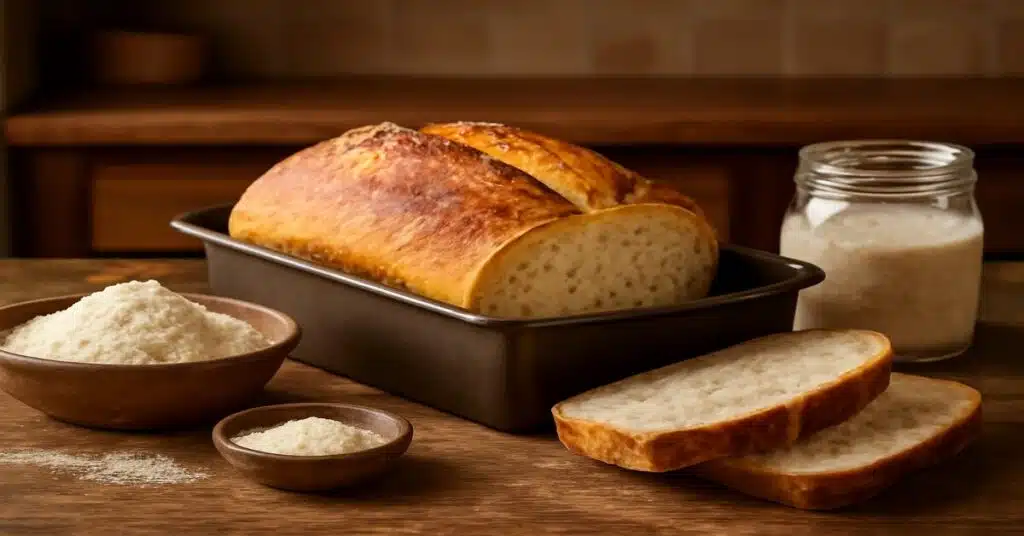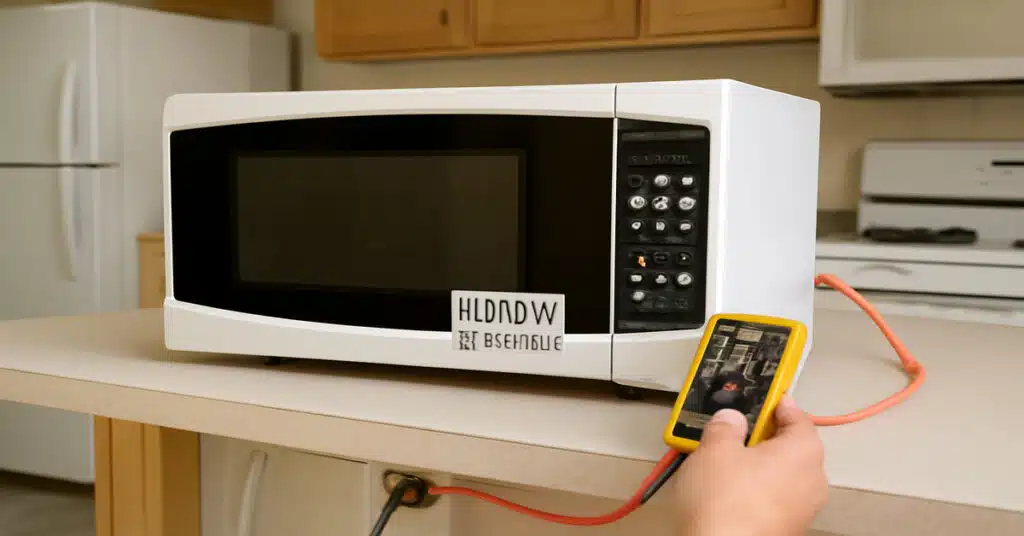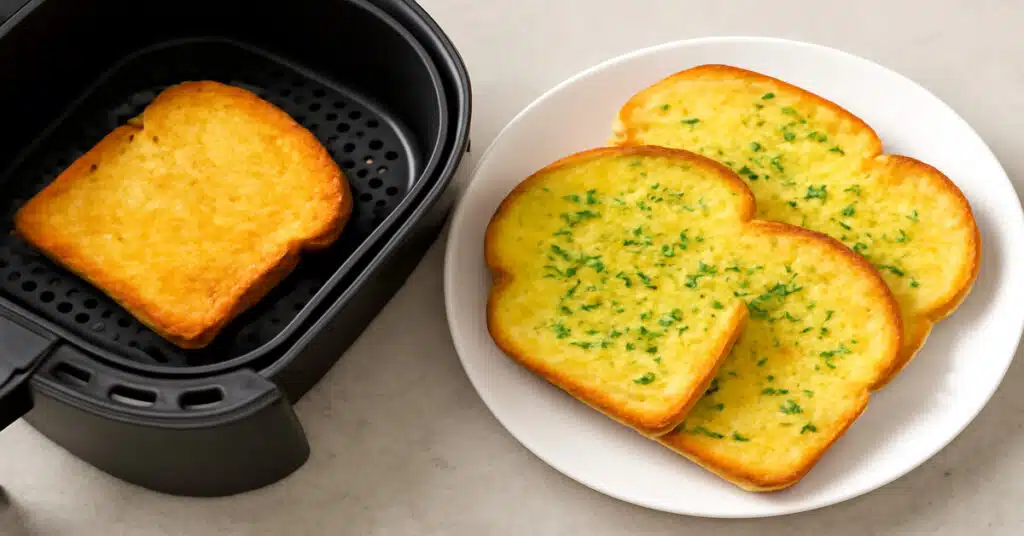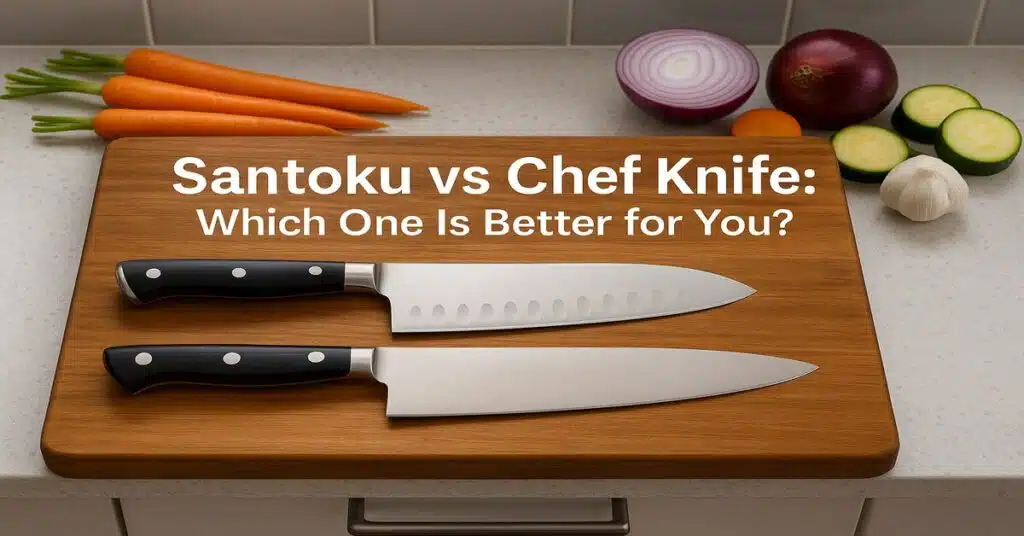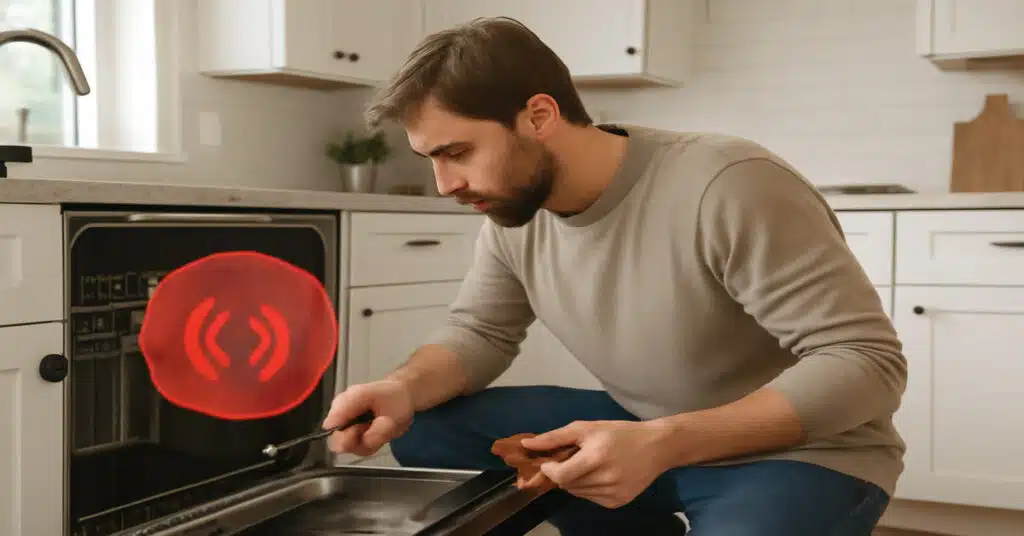Are silicone baking mats safe? I asked myself that the first time, my cookies stuck badly to the tray. A friend suggested using a silicone mat, but I was not sure if it was safe in the oven. So, I researched, tested it in my kitchen, and spoke to other bakers. Over time, I found these mats made baking easier and cleaner. But like many people, I still wondered about health and safety. In this article, I will share what I have learned from real experience—so you can decide if silicone baking mats are the right choice for your kitchen.
Are Silicone Baking Mats Non-Toxic?
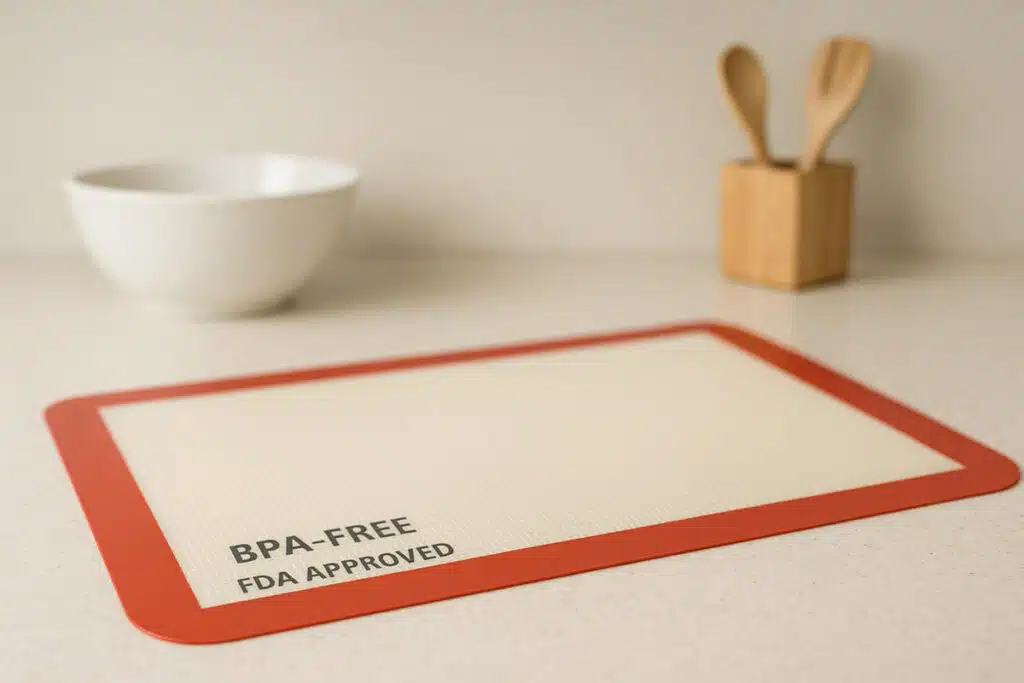
When I first started using silicone baking mats, the first question I had was: Are silicone baking mats non-toxic? I had young kids at home, and I did not want to risk anything that might affect our food or health.
After doing some deep research and speaking to other home bakers, I found that most good-quality mats are made from food-grade silicone. This type of silicone is safe for baking and does not release harmful chemicals when used properly. I made sure to buy FDA-approved, BPA-free mats from trusted brands—not the cheap ones that often look and feel off.
I have baked everything from cookies to grilled veggies on these mats. They never gave off a bad smell or left any strange residue, even after months of use.
One thing I have learned: if a mat feels too soft, bends too easily, or has a strong rubber smell—it’s best to avoid it. These can be signs of low-quality material.
So yes, based on my own experience, silicone baking mats are non-toxic—as long as you choose high-quality, food-safe options and use them the right way.
How Safe Are Silicone Baking Mats for Baking?
When I first switched from parchment paper to silicone baking mats, it was mainly for convenience. But soon, I found myself asking: how safe are silicone baking mats for baking? I bake almost every day, so I had to be sure they were safe to use regularly.
From my own experience, silicone mats make baking both easier and safer. They do not burn like paper, they do not need extra oil, and they stay in place. That means fewer burns, less mess, and quick cleanup. I have used them for cookies, pizzas, and even reheating last night’s dinner—and they have worked every time.
Over the years, I have learned a few key silicone baking mat safety tips:
- Never cut on the mat – it weakens the surface.
- Avoid broilers – direct flames can damage it.
- Clean regularly – leftover oil can build up over time.
As long as I stay below 480°F and stick to quality mats, I’ve never had issues. Just like any kitchen tool, their safety depends on how you use them. With the right care, silicone baking mats have become one of the most useful tools in my kitchen.
Are Silicone Baking Mats Safe to Use in the Oven?
One of the first things I asked before trying one was, are silicone baking mats oven safe? I did not want to risk damaging my oven—or worse, ruin a fresh batch of cookies.
After years of regular baking, I can confidently say yes, they are safe—as long as you use them correctly. Food-grade silicone mats can typically handle heat up to 480°F, and I usually bake between 350–425°F without any issues.
From my own kitchen, I have used them for everything—cookies, roasted veggies, even pizza. They have held up perfectly.
But here is a key tip: never use them under a broiler. Direct flames or super-high heat can cause damage or melting. Also, avoid placing them on an open flame or in extreme temperature changes.
So, are silicone baking mats oven safe? Yes—just use them wisely and choose trusted, high-quality mats.
What Are the Risks of Silicone Baking Mats?
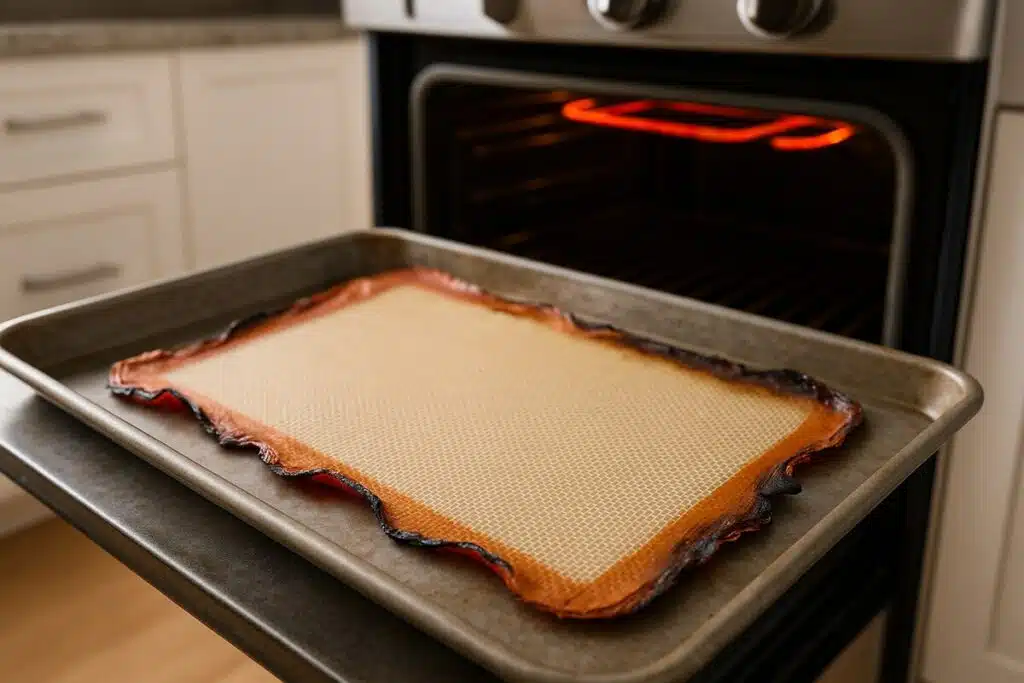
After years of using silicone baking mats in my kitchen, I have learned they are helpful—but only if used the right way.
I once forgot to remove a mat before using the broiler. Within minutes, the edges turned brown and started to smell bad. That moment taught me an important lesson—exposing silicone mats to very high heat or open flames can damage them.
People often ask me, “Are silicone baking mats toxic?” The truth is, some cheap mats made with fillers can be unsafe. That is why I always use FDA-approved, BPA-free mats.
So, are silicone baking mats safe for health? Yes—if you choose good-quality mats and use them properly. But if the mat feels rubbery, melts easily, or smells strange, it is best to stop using it.
Avoid these common mistakes:
- Using the mat under a broiler
- Heating it above 480°F
- Buying low-quality, uncertified mats
With the right mat and a few precautions, you can use silicone baking mats safely—and enjoy all the baking benefits without worry.
Can Silicone Baking Mats Cause Cancer?
I remember a student once asked me, “Can silicone baking mats cause cancer?” It was not a silly question—I had wondered the same thing myself years ago.
Like many people, I had seen scary headlines online. So, I did my research and tested the mats in my own kitchen. What I learned was clear: food-grade silicone mats are considered safe when used the right way.
They are made without BPA, phthalates, or other known cancer-causing chemicals. Pure silicone is non-toxic and heat-resistant up to 480°F.
The real risk comes from:
- Buying low-quality mats with unknown fillers
- Overheating beyond safe temperatures
- Using mats on open flames or under a broiler
Trusted sources, including FDA guidelines, show no link between pure silicone and cancer when used correctly.
So, can silicone baking mats cause cancer?
No—not if you are using high-quality, certified mats and baking safely.
I have used them for years without a single issue. I always recommend FDA-approved mats to my students and family, because peace of mind matters when you are feeding the people you care about.
Are Silicone Baking Mats Safe for Food?
When I first used silicone baking mats, I had one big question in my mind:
Are silicone baking mats safe for food?
I have kids at home, so I wanted to be sure that nothing harmful was ending up on their plates.
After testing them in my kitchen and doing some research, I found that food-grade silicone mats are designed to be safe for direct contact with food. They do not need extra oil, they are non-stick, and they do not leave any residue behind.
I have used them to bake cookies, reheat pizza, and roast veggies. The food always turns out clean and chemical-free.
But here is what I have learned through experience:
Not all silicone mats are made the same. Some cheap ones may contain fillers or unsafe materials that can break down under heat.
So for silicone baking mats and food safety, keep this in mind:
- Use BPA-free, FDA-approved mats
- Avoid mats that smell like rubber or discolor easily
**Yes, silicone baking mats are safe for food—**as long as you choose high-quality ones. One good mat can keep your baking safe for years.
Do Silicone Baking Mats Contain Harmful Chemicals?
I am someone who always checks what touches our food—especially since I bake for my kids, my students, and sometimes big family events. I still remember one time I bought a cheap mat online. It looked fine, but when I put it in the oven, it gave off a strong rubbery smell. I did not feel right about it, so I threw it away after just one use.
That experience taught me a lot.
What I Learned:
- Good-quality silicone mats are made from 100% food-grade silicone
- They are BPA-free, phthalate-free, and lead-free
- They do not release harmful chemicals when used below 480°F
However, cheap mats may contain fillers that break down under heat. That is what causes bad smells, discoloration, or sticky residue on food.
What I Do Now:
- I only buy FDA-approved, non-toxic baking mats
- I avoid mats with a strong smell or those that turn sticky or yellow
So, do silicone mats contain harmful chemicals?
Not if you choose the right kind. Go for trusted brands, and you will bake with peace of mind every time.
Are Silicone Mats Safe for Health?
I had the same concern years ago when I bought a cheap mat from a local market. At first, it seemed okay. But after just two bakes, it gave off a strong smell and felt sticky. I did not take chances—I threw it out immediately.
That experience taught me something important: not all silicone mats are safe.
Since then, I only use BPA-free, food-grade silicone mats that are FDA-approved. These are designed to be safe at oven temperatures up to 480°F. I have used them for years while baking cookies, roasting vegetables, and even teaching kids—and never had health problems.
✅ What I’ve Learned:
- Cheap mats may contain unsafe fillers that break down under heat
- High-quality mats are non-toxic, durable, and don’t react with food
- Look for trusted brands with proper safety certifications
So, are silicone mats safe for health?
Yes—if you choose the right ones. I trust them in my kitchen every day—and I teach others to do the same.
Silicone Baking Mats vs. Parchment Paper: Which Is Better?
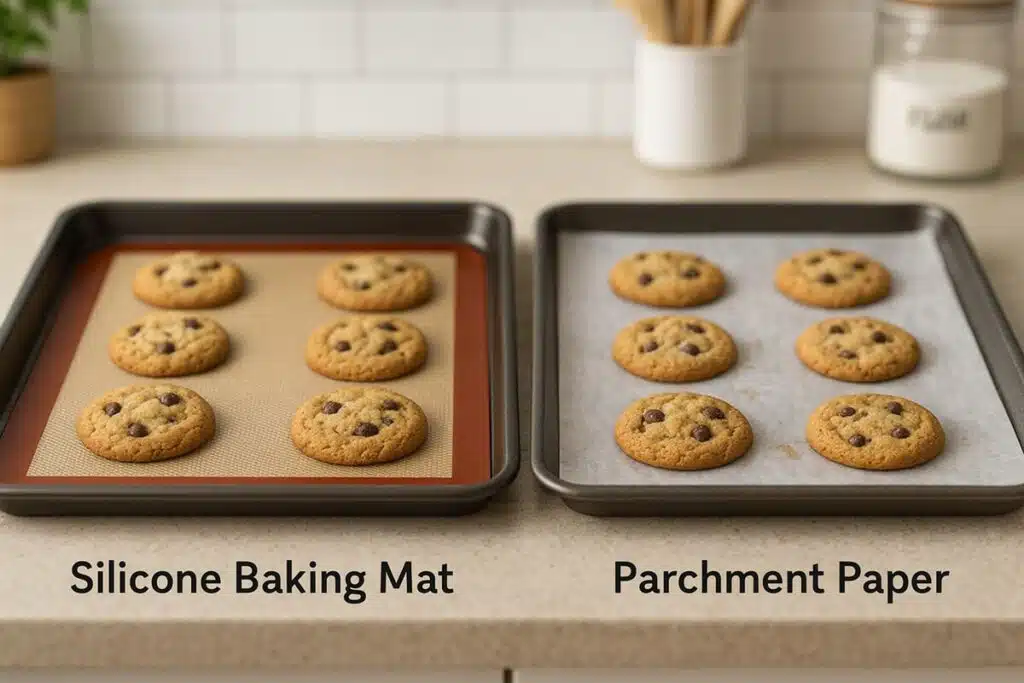
As a baking teacher who bakes almost every day,I have used both silicone baking mats and parchment paper many times. People often ask me, “Are silicone baking mats better than parchment paper?” The answer really depends on how often you bake and what you are making.
Comparison Table: Silicone Mats vs Parchment Paper vs Aluminum Foil:
| Feature | Silicone Baking Mats | Parchment Paper | Aluminum Foil |
| Safety | ✅ Food-grade, BPA-free, safe up to 450°F | ✅ Safe, but may contain chemicals (bleached/unbleached) | ⚠️ Can react with acidic/salty foods |
| Reusability | ♻️ Reusable for 3–5 years (proper care) | ❌ Single-use only | ⚠️ Sometimes reusable but degrades fast |
| Eco-Friendly | 🌱 Very eco-friendly, reduces kitchen waste | ❌ Creates waste (disposable) | ❌ Not eco-friendly (energy intensive) |
| Heat Resistance | 🔥 Up to 450°F (232°C) | 🔥 Up to ~425°F (218°C) | 🔥 Very high, but uneven heating risk |
| Cost Efficiency | 💰 One-time investment, long-term savings | 💵 Cheap upfront but recurring expense | 💵 Moderate, not cost-effective long-term |
I still remember one class where I ran out of parchment paper mid-demo. I quickly grabbed my silicone mat, and the results surprised everyone. The cookies baked evenly, didn’t stick, and the cleanup was quick. Since then, I have been using silicone mats regularly.
✅ Why I Prefer Silicone Baking Mats (Most of the Time):
- Reusable – I have used the same mat for over Three years and it still works well.
- Non-stick – No oil or butter needed.
- Eco-friendly – Saves money and cuts down on waste.
- Perfect for daily baking – Great for cookies, flatbreads, and roasted veggies.
📝 When I Still Use Parchment Paper:
- For very oily foods
- When baking something sticky like brownies
- When I need to line a pan for easy cleanup or serving
So, in the silicone baking mats vs parchment paper debate—silicone mats win in my kitchen for everyday baking. But both have their place.
How Long Do Silicone Baking Mats Last?
In my kitchen and baking classes, I have used silicone baking mats almost daily. One of the most common questions I hear is: “How long do silicone baking mats last?”
Based on my real experience, a good mat lasts 2 to 5 years with proper care.
I still use one I bought over three years ago. I have baked hundreds of cookie batches, roasted vegetables, and even warmed up leftover pizza on it. It is held up really well.
✅ What I’ve Learned About the Durability of Silicone Baking Mats:
- Don’t cut directly on the mat—it can damage the surface.
- Never use it under a broiler or near open flames.
- Clean it gently using warm water and mild soap.
If you follow these tips, your mat will last for years. That saves you money and keeps your baking safe.
So, how long do silicone baking mats last?
With proper care, they last a long time—and I use mine every day. I always recommend them to my students because they are strong, safe, and worth it.
Silicone Baking Mats: A Green Choice – Eco-Friendly Benefits
As someone who bakes daily—at home and in class—I care about the tools I use and the waste they create. I used to go through lots of parchment paper. One day after baking cookies with my students, I saw the trash full of used sheets.That is when I switched to silicone baking mats—and I have never looked back.
Are silicone baking mats eco-friendly? From my experience, yes. I have used the same mat for over three years. It is reusable, easy to clean, and saves money. That means less waste, fewer trips to buy paper, and a cleaner kitchen.
Plus, when it comes to silicone baking mats and food safety, quality mats are safe. I always choose BPA-free, food-grade silicone.
I now teach my students: eco-friendly baking starts with smart choices—and a good silicone mat is one of them.
Silicone Baking Mat Safety Tips
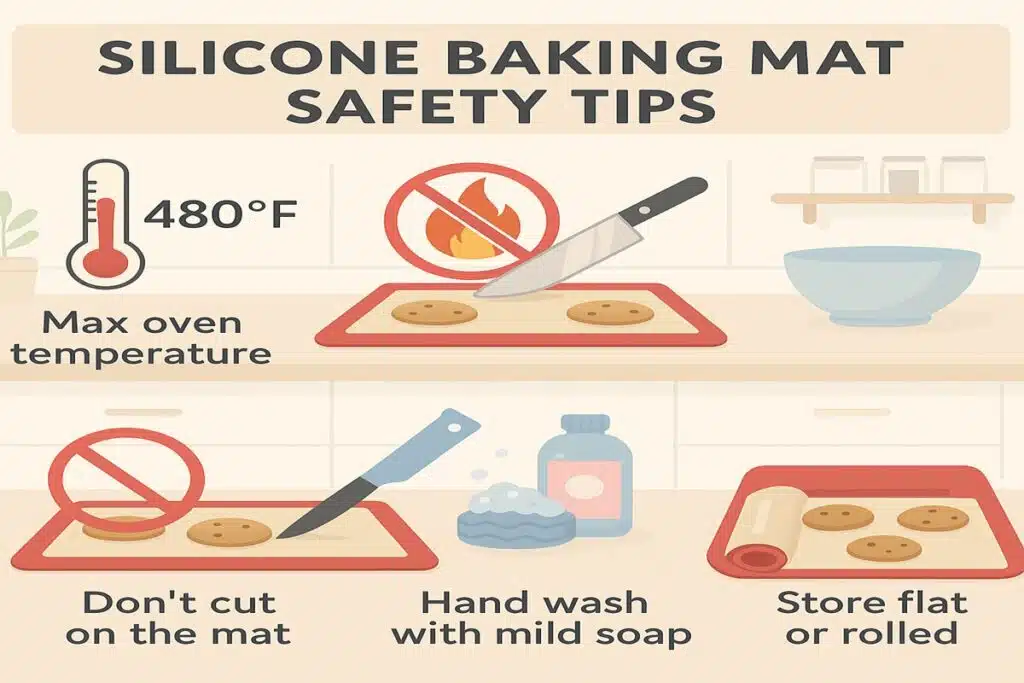
Over time, I have learned that using silicone baking mats safely makes a big difference—not just in baking results, but also in health and durability. I have used these mats for years and teach my students the same.
Here are my best silicone baking mat safety tips:
- Stay below 480°F – High heat can damage the mat. I usually bake at 350–425°F.
- Never use under a broiler or on an open flame – I made that mistake once, and the mat melted.
- Don’t cut food on the mat – It weakens the surface. Always move food to a cutting board.
- Clean gently – Use warm water and mild soap. Avoid scrubbing too hard.
- Store it flat or rolled – Folding can cause cracks over time.
I always tell my students: a little care goes a long way. These mats are safe and long-lasting—if you use
Conclusion: Are Silicone Baking Mats Worth It?
Are silicone baking mats worth it? From my real experience as a baker and teacher—yes, 100%.
They are easy to use, safe when made from food-grade silicone, and save both time and money. I have used the same mat for years. It still works great.
Just be sure to avoid cheap mats. Always choose BPA-free, high-quality options, and follow the basic care tips I have shared. If you want safer baking, less waste, and better results, a silicone baking mat is a smart, eco-friendly tool. I use them daily—and always recommend them to my students with confidence.
FAQ
Are silicone baking mats dishwasher safe?
Ans: Yes. But I prefer hand-washing to help them last longer.
How do you clean silicone baking mats?
Ans: Use warm water, mild soap, and a soft sponge. Avoid rough scrubbing.
Are silicone baking mats oven safe?
Ans: Yes. They’re safe up to 480°F, but not for broilers or open flames.
Can silicone baking mats be reused?
Ans: Yes! They are reusable for years if cared for properly.
Are silicone baking mats better than parchment paper?
Ans: Yes, in most cases. They are non-stick, eco-friendly, and reusable.
How long do silicone baking mats last?
Ans: High-quality silicone baking mats typically last 3–5 years with proper care. Replace them if they become cracked, sticky, or discolored.
Can silicone baking mats go in the dishwasher?
Ans: Yes, most silicone mats are dishwasher safe. However, hand washing with mild soap is recommended to extend their lifespan.
Are silicone mats safer than parchment paper?
Ans: Yes. Since silicone mats are reusable and non-toxic, they are often considered a safer and more sustainable option compared to parchment paper.
About the Author:
Md Soazim is a passionate home baker and kitchen product reviewer with years of hands-on experience testing bakeware and cookware. Having used both parchment paper and silicone baking mats in daily baking, he provides practical, unbiased advice to help readers choose safer and eco-friendly kitchen options. His goal is to simplify kitchen decisions by combining personal experience with trusted research from sources like the FDA and Healthline.


